Luziwei Leng
SpikingMamba: Towards Energy-Efficient Large Language Models via Knowledge Distillation from Mamba
Oct 06, 2025
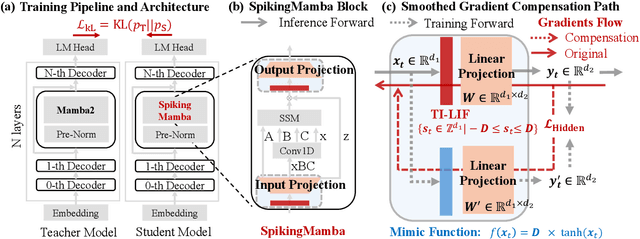


Abstract:Large Language Models (LLMs) have achieved remarkable performance across tasks but remain energy-intensive due to dense matrix operations. Spiking neural networks (SNNs) improve energy efficiency by replacing dense matrix multiplications with sparse accumulations. Their sparse spike activity enables efficient LLMs deployment on edge devices. However, prior SNN-based LLMs often sacrifice performance for efficiency, and recovering accuracy typically requires full pretraining, which is costly and impractical. To address this, we propose SpikingMamba, an energy-efficient SNN-based LLMs distilled from Mamba that improves energy efficiency with minimal accuracy sacrifice. SpikingMamba integrates two key components: (a) TI-LIF, a ternary-integer spiking neuron that preserves semantic polarity through signed multi-level spike representations. (b) A training-exclusive Smoothed Gradient Compensation (SGC) path mitigating quantization loss while preserving spike-driven efficiency. We employ a single-stage distillation strategy to transfer the zero-shot ability of pretrained Mamba and further enhance it via reinforcement learning (RL). Experiments show that SpikingMamba-1.3B achieves a 4.76$\times$ energy benefit, with only a 4.78\% zero-shot accuracy gap compared to the original Mamba, and achieves a further 2.55\% accuracy improvement after RL.
Threshold Modulation for Online Test-Time Adaptation of Spiking Neural Networks
May 08, 2025



Abstract:Recently, spiking neural networks (SNNs), deployed on neuromorphic chips, provide highly efficient solutions on edge devices in different scenarios. However, their ability to adapt to distribution shifts after deployment has become a crucial challenge. Online test-time adaptation (OTTA) offers a promising solution by enabling models to dynamically adjust to new data distributions without requiring source data or labeled target samples. Nevertheless, existing OTTA methods are largely designed for traditional artificial neural networks and are not well-suited for SNNs. To address this gap, we propose a low-power, neuromorphic chip-friendly online test-time adaptation framework, aiming to enhance model generalization under distribution shifts. The proposed approach is called Threshold Modulation (TM), which dynamically adjusts the firing threshold through neuronal dynamics-inspired normalization, being more compatible with neuromorphic hardware. Experimental results on benchmark datasets demonstrate the effectiveness of this method in improving the robustness of SNNs against distribution shifts while maintaining low computational cost. The proposed method offers a practical solution for online test-time adaptation of SNNs, providing inspiration for the design of future neuromorphic chips. The demo code is available at github.com/NneurotransmitterR/TM-OTTA-SNN.
Scaling Spike-driven Transformer with Efficient Spike Firing Approximation Training
Nov 25, 2024Abstract:The ambition of brain-inspired Spiking Neural Networks (SNNs) is to become a low-power alternative to traditional Artificial Neural Networks (ANNs). This work addresses two major challenges in realizing this vision: the performance gap between SNNs and ANNs, and the high training costs of SNNs. We identify intrinsic flaws in spiking neurons caused by binary firing mechanisms and propose a Spike Firing Approximation (SFA) method using integer training and spike-driven inference. This optimizes the spike firing pattern of spiking neurons, enhancing efficient training, reducing power consumption, improving performance, enabling easier scaling, and better utilizing neuromorphic chips. We also develop an efficient spike-driven Transformer architecture and a spike-masked autoencoder to prevent performance degradation during SNN scaling. On ImageNet-1k, we achieve state-of-the-art top-1 accuracy of 78.5\%, 79.8\%, 84.0\%, and 86.2\% with models containing 10M, 19M, 83M, and 173M parameters, respectively. For instance, the 10M model outperforms the best existing SNN by 7.2\% on ImageNet, with training time acceleration and inference energy efficiency improved by 4.5$\times$ and 3.9$\times$, respectively. We validate the effectiveness and efficiency of the proposed method across various tasks, including object detection, semantic segmentation, and neuromorphic vision tasks. This work enables SNNs to match ANN performance while maintaining the low-power advantage, marking a significant step towards SNNs as a general visual backbone. Code is available at https://github.com/BICLab/Spike-Driven-Transformer-V3.
Spatial-Temporal Search for Spiking Neural Networks
Oct 24, 2024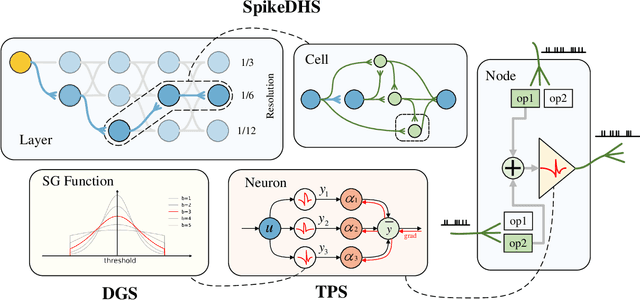

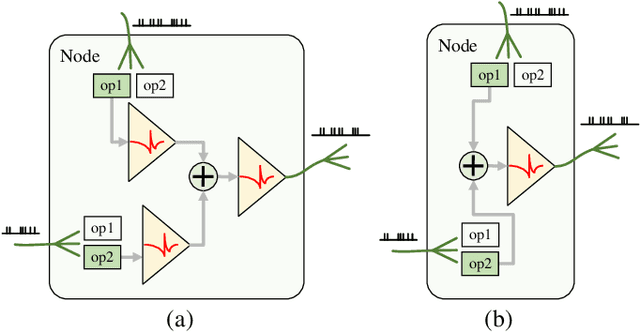
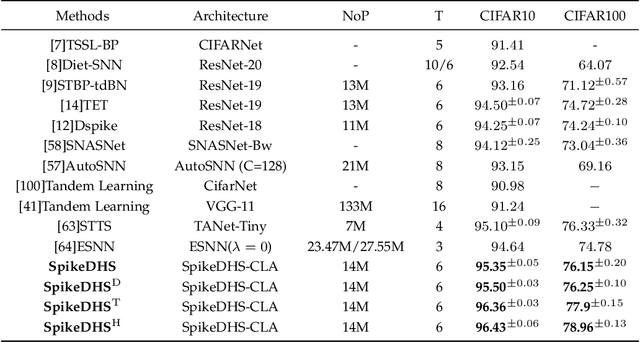
Abstract:Spiking Neural Networks (SNNs) are considered as a potential candidate for the next generation of artificial intelligence with appealing characteristics such as sparse computation and inherent temporal dynamics. By adopting architectures of Artificial Neural Networks (ANNs), SNNs achieve competitive performances on benchmark tasks like image classification. However, successful architectures of ANNs are not optimal for SNNs. In this work, we apply Neural Architecture Search (NAS) to find suitable architectures for SNNs. Previous NAS methods for SNNs focus primarily on the spatial dimension, with a notable lack of consideration for the temporal dynamics that are of critical importance for SNNs. Drawing inspiration from the heterogeneity of biological neural networks, we propose a differentiable approach to optimize SNN on both spatial and temporal dimensions. At spatial level, we have developed a spike-based differentiable hierarchical search (SpikeDHS) framework, where spike-based operation is optimized on both the cell and the layer level under computational constraints. We further propose a differentiable surrogate gradient search (DGS) method to evolve local SG functions independently during training. At temporal level, we explore an optimal configuration of diverse temporal dynamics on different types of spiking neurons by evolving their time constants, based on which we further develop hybrid networks combining SNN and ANN, balancing both accuracy and efficiency. Our methods achieve comparable classification performance of CIFAR10/100 and ImageNet with accuracies of 96.43%, 78.96%, and 70.21%, respectively. On event-based deep stereo, our methods find optimal layer variation and surpass the accuracy of specially designed ANNs with 26$\times$ lower computational cost ($6.7\mathrm{mJ}$), demonstrating the potential of SNN in processing highly sparse and dynamic signals.
SpikingSSMs: Learning Long Sequences with Sparse and Parallel Spiking State Space Models
Aug 27, 2024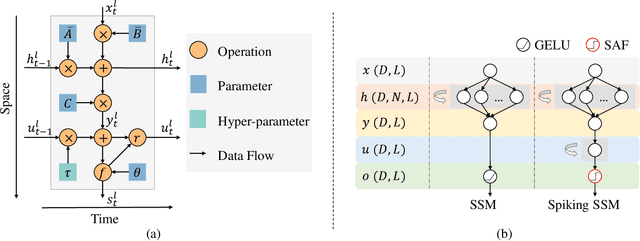
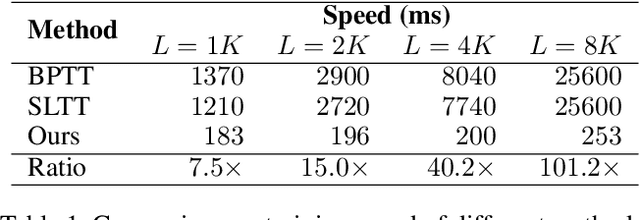
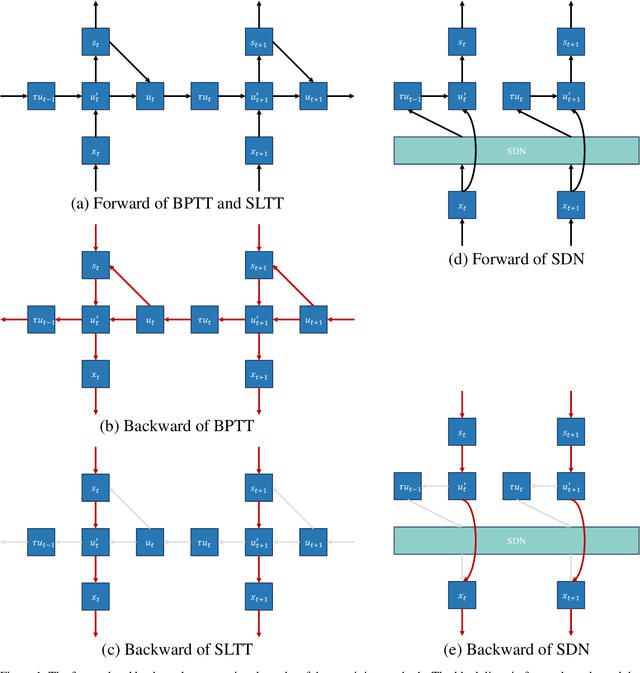

Abstract:Known as low energy consumption networks, spiking neural networks (SNNs) have gained a lot of attention within the past decades. While SNNs are increasing competitive with artificial neural networks (ANNs) for vision tasks, they are rarely used for long sequence tasks, despite their intrinsic temporal dynamics. In this work, we develop spiking state space models (SpikingSSMs) for long sequence learning by leveraging on the sequence learning abilities of state space models (SSMs). Inspired by dendritic neuron structure, we hierarchically integrate neuronal dynamics with the original SSM block, meanwhile realizing sparse synaptic computation. Furthermore, to solve the conflict of event-driven neuronal dynamics with parallel computing, we propose a light-weight surrogate dynamic network which accurately predicts the after-reset membrane potential and compatible to learnable thresholds, enabling orders of acceleration in training speed compared with conventional iterative methods. On the long range arena benchmark task, SpikingSSM achieves competitive performance to state-of-the-art SSMs meanwhile realizing on average 90\% of network sparsity. On language modeling, our network significantly surpasses existing spiking large language models (spikingLLMs) on the WikiText-103 dataset with only a third of the model size, demonstrating its potential as backbone architecture for low computation cost LLMs.
Towards Scalable GPU-Accelerated SNN Training via Temporal Fusion
Aug 01, 2024



Abstract:Drawing on the intricate structures of the brain, Spiking Neural Networks (SNNs) emerge as a transformative development in artificial intelligence, closely emulating the complex dynamics of biological neural networks. While SNNs show promising efficiency on specialized sparse-computational hardware, their practical training often relies on conventional GPUs. This reliance frequently leads to extended computation times when contrasted with traditional Artificial Neural Networks (ANNs), presenting significant hurdles for advancing SNN research. To navigate this challenge, we present a novel temporal fusion method, specifically designed to expedite the propagation dynamics of SNNs on GPU platforms, which serves as an enhancement to the current significant approaches for handling deep learning tasks with SNNs. This method underwent thorough validation through extensive experiments in both authentic training scenarios and idealized conditions, confirming its efficacy and adaptability for single and multi-GPU systems. Benchmarked against various existing SNN libraries/implementations, our method achieved accelerations ranging from $5\times$ to $40\times$ on NVIDIA A100 GPUs. Publicly available experimental codes can be found at https://github.com/EMI-Group/snn-temporal-fusion.
Evolutionary Spiking Neural Networks: A Survey
Jun 18, 2024Abstract:Spiking neural networks (SNNs) are gaining increasing attention as potential computationally efficient alternatives to traditional artificial neural networks(ANNs). However, the unique information propagation mechanisms and the complexity of SNN neuron models pose challenges for adopting traditional methods developed for ANNs to SNNs. These challenges include both weight learning and architecture design. While surrogate gradient learning has shown some success in addressing the former challenge, the latter remains relatively unexplored. Recently, a novel paradigm utilizing evolutionary computation methods has emerged to tackle these challenges. This approach has resulted in the development of a variety of energy-efficient and high-performance SNNs across a wide range of machine learning benchmarks. In this paper, we present a survey of these works and initiate discussions on potential challenges ahead.
Benchmarking Neural Decoding Backbones towards Enhanced On-edge iBCI Applications
Jun 08, 2024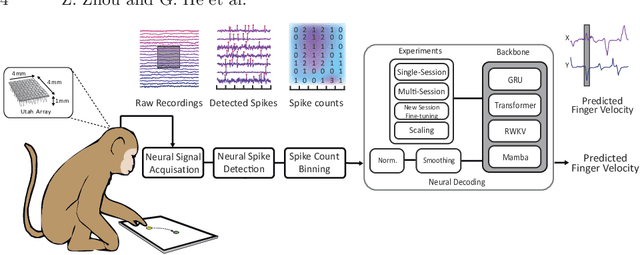

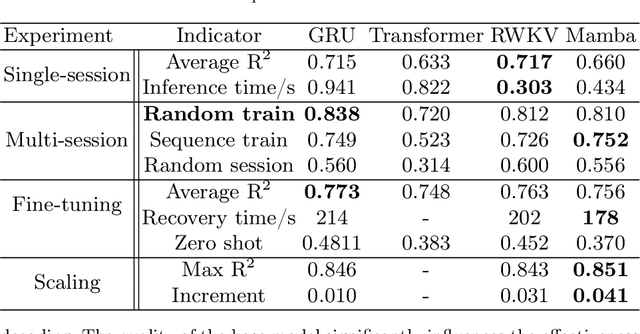
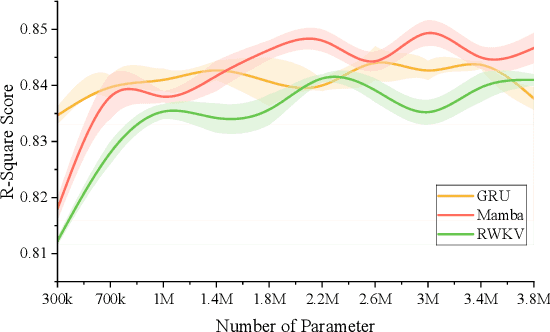
Abstract:Traditional invasive Brain-Computer Interfaces (iBCIs) typically depend on neural decoding processes conducted on workstations within laboratory settings, which prevents their everyday usage. Implementing these decoding processes on edge devices, such as the wearables, introduces considerable challenges related to computational demands, processing speed, and maintaining accuracy. This study seeks to identify an optimal neural decoding backbone that boasts robust performance and swift inference capabilities suitable for edge deployment. We executed a series of neural decoding experiments involving nonhuman primates engaged in random reaching tasks, evaluating four prospective models, Gated Recurrent Unit (GRU), Transformer, Receptance Weighted Key Value (RWKV), and Selective State Space model (Mamba), across several metrics: single-session decoding, multi-session decoding, new session fine-tuning, inference speed, calibration speed, and scalability. The findings indicate that although the GRU model delivers sufficient accuracy, the RWKV and Mamba models are preferable due to their superior inference and calibration speeds. Additionally, RWKV and Mamba comply with the scaling law, demonstrating improved performance with larger data sets and increased model sizes, whereas GRU shows less pronounced scalability, and the Transformer model requires computational resources that scale prohibitively. This paper presents a thorough comparative analysis of the four models in various scenarios. The results are pivotal in pinpointing an optimal backbone that can handle increasing data volumes and is viable for edge implementation. This analysis provides essential insights for ongoing research and practical applications in the field.
Weakly-Supervised Action Localization by Hierarchically-structured Latent Attention Modeling
Aug 19, 2023Abstract:Weakly-supervised action localization aims to recognize and localize action instancese in untrimmed videos with only video-level labels. Most existing models rely on multiple instance learning(MIL), where the predictions of unlabeled instances are supervised by classifying labeled bags. The MIL-based methods are relatively well studied with cogent performance achieved on classification but not on localization. Generally, they locate temporal regions by the video-level classification but overlook the temporal variations of feature semantics. To address this problem, we propose a novel attention-based hierarchically-structured latent model to learn the temporal variations of feature semantics. Specifically, our model entails two components, the first is an unsupervised change-points detection module that detects change-points by learning the latent representations of video features in a temporal hierarchy based on their rates of change, and the second is an attention-based classification model that selects the change-points of the foreground as the boundaries. To evaluate the effectiveness of our model, we conduct extensive experiments on two benchmark datasets, THUMOS-14 and ActivityNet-v1.3. The experiments show that our method outperforms current state-of-the-art methods, and even achieves comparable performance with fully-supervised methods.
Automotive Object Detection via Learning Sparse Events by Temporal Dynamics of Spiking Neurons
Jul 24, 2023Abstract:Event-based sensors, with their high temporal resolution (1us) and dynamical range (120dB), have the potential to be deployed in high-speed platforms such as vehicles and drones. However, the highly sparse and fluctuating nature of events poses challenges for conventional object detection techniques based on Artificial Neural Networks (ANNs). In contrast, Spiking Neural Networks (SNNs) are well-suited for representing event-based data due to their inherent temporal dynamics. In particular, we demonstrate that the membrane potential dynamics can modulate network activity upon fluctuating events and strengthen features of sparse input. In addition, the spike-triggered adaptive threshold can stabilize training which further improves network performance. Based on this, we develop an efficient spiking feature pyramid network for event-based object detection. Our proposed SNN outperforms previous SNNs and sophisticated ANNs with attention mechanisms, achieving a mean average precision (map50) of 47.7% on the Gen1 benchmark dataset. This result significantly surpasses the previous best SNN by 9.7% and demonstrates the potential of SNNs for event-based vision. Our model has a concise architecture while maintaining high accuracy and much lower computation cost as a result of sparse computation. Our code will be publicly available.
 Add to Chrome
Add to Chrome Add to Firefox
Add to Firefox Add to Edge
Add to Edge